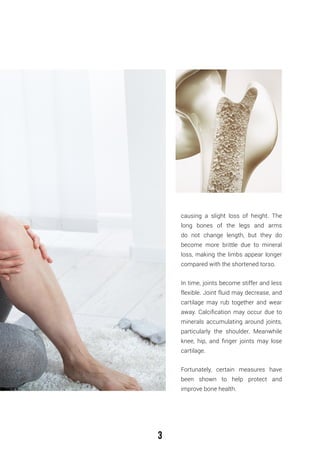The Impact of the Aging Process on Bone Health
- 1. Aging Process on Bone Health Dr Carolyn Dean is a medical doctor and naturopath. She has authored and co-authored over 35 books T h e I m pa ct of t he
- 2. 2 The Impact of the Aging Process on Bone Health As people grow older, changes in posture and gait are common. People lose bone density or mass, particularly women after the menopause. Vertebra in the spine are separated by a gel-like cushion called a ŌĆśdiskŌĆÖ. As an individual ages, the midriff becomes shorter as disks lose fluid and become thinner. Bones, including vertebrae, also lose calcium and mineral content with age, leaving each bone thinner. The spinal column becomes compressed and curved. In some people, aging and overall use of the spine creates bone spurs on the vertebrae. As a person grows older, their foot arches become less pronounced,
- 3. 3 causing a slight loss of height. The long bones of the legs and arms do not change length, but they do become more brittle due to mineral loss, making the limbs appear longer compared with the shortened torso. In time, joints become stiffer and less flexible. Joint fluid may decrease, and cartilage may rub together and wear away. Calcification may occur due to minerals accumulating around joints, particularly the shoulder. Meanwhile knee, hip, and finger joints may lose cartilage. Fortunately, certain measures have been shown to help protect and improve bone health.
- 4. visiting the blog of You can learn more about the importance of diet and exercise in protecting bone health by Dr. Carolyne Dean




